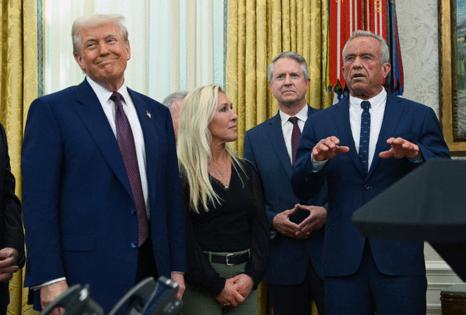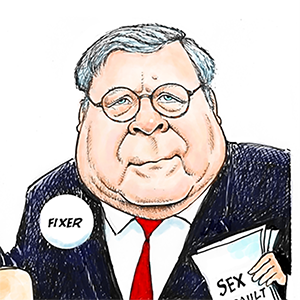Republicans are eyeing cuts to Medicaid. What's Medicaid, again?
Published in News & Features
In January, during a congressional hearing on his way to becoming secretary of the Department of Health and Human Services, Robert F. Kennedy Jr. got basic details wrong about Medicaid — a program he now oversees.
He said that Medicaid is fully funded by the federal government (it’s not) and that many enrollees are unsatisfied with high out-of-pocket costs (enrollees pay limited, if any, out-of-pocket costs).
Medicaid is complex. The $880 billion-a-year state-federal program offers health coverage to millions of disabled and low-income Americans. The program covers different services for different people in different parts of the country — and enrollees may interact with private insurance companies without “Medicaid” in their names, leaving some unaware that they’re on the program at all.
Although President Donald Trump promised to “love and cherish” Medicaid, Republicans in Congress have announced federal budget proposals that could dramatically curtail the program. As that debate begins, here is what you need to know about Medicaid.
What is Medicaid, and how is it different from Medicare?
Medicaid and Medicare were created by the same legislation — an addition to the Social Security Act — that was signed into law by President Lyndon B. Johnson in 1965.
Medicaid is a government health insurance program for people with low incomes and adults and children with disabilities.
Medicare, by contrast, generally covers those 65 or older.
For older Americans with low incomes, Medicaid covers out-of-pocket costs for Medicare. Such people are commonly called “dual eligibles,” because they qualify for both programs.
Who is on Medicaid?
More than 79 million people receive services from Medicaid or the closely related Children’s Health Insurance Program. That represents about 20% of the total population of the United States. Most enrollees qualify because of low incomes.
About 40% of all children in the country are covered by Medicaid or CHIP, created in 1997. Both pay for services such as routine checkups, vaccinations, and hospital stays. Medicaid also covers pregnant people before and after they give birth and pays for more than 40% of all births.
Medicaid also covers people with disabilities or complex medical needs and helps them afford services that allow them to live independently in community settings, outside of institutions such as nursing homes and state-run hospitals.
The program serves a diverse cross section of the country. About 40% of people under 65 who use Medicaid are white, 30% are Hispanic, 19% are Black, and 1% are Indigenous people.
Federal Medicaid dollars cannot be used to cover immigrants who are in the U.S. without legal permission, though some states, as well as Washington, D.C., have used their own funds to extend Medicaid coverage to such individuals. California was the first state to do so.
What are the income qualifications?
Eligibility generally depends on whether a person is low income, and states have different ways of defining that. For a four-adult household without dependent children, the current national median coverage level is $44,367.
The Affordable Care Act, often called Obamacare, which passed in 2010, allowed more people to qualify for Medicaid on the basis of income. This is what is known as “Medicaid expansion.”
The law offered states a sizable incentive to add more people to their programs: The federal government would pitch in more money per enrollee to help cover them.
The intention behind the expansion was to close gaps in health insurance programs for the millions of Americans who don’t get coverage through an employer. Medicaid would cover people with extremely low incomes, and as their incomes rose, they could move to subsidized health plans sold through the Affordable Care Act’s exchanges.
In 2012, the U.S. Supreme Court said the decision of whether to expand the program would be left up to individual states. Today, 40 states and the District of Columbia — led by Democrats and Republicans alike — have opted in.
In the 10 states that haven’t expanded Medicaid to more low-income adults, the median earnings qualification level is $5,947 a year for a single-person household in 2025. Those who make more are not eligible.
Adults in those states who make too much for Medicaid can also make too little to qualify for help buying plans on the Affordable Care Act exchanges, leaving some unable to afford coverage. An estimated 1.5 million fall into this coverage gap.
Where does the money to pay for it come from?
The federal government pays most of the cost of Medicaid by matching a portion of what states spend.
Currently, the federal government matches at least 50% of state spending and offers states more money for some services and enrollees — for instance, for children and pregnant women.
Less wealthy states — determined by considering residents’ per capita incomes — receive a higher match, translating to a higher percentage of federal dollars. In Mississippi, for instance, the federal government picks up 77% of the cost of Medicaid.
States also receive a 90% match from the federal government for enrollees eligible for Medicaid under the ACA’s expansion.
There is no limit on how much states can spend on the program, and hundreds of billions of federal dollars flow into states each year. In 2023, states spent about 15% of their own budgets on Medicaid.
What does that money pay for?
Federal law requires all state Medicaid programs to cover certain services, including emergency medical transportation, X-rays and lab work, family planning, and medication-assisted treatment for people with opioid use disorder. The program also covers many nursing and home health services, though federal law allows those benefits to be clawed back after an enrollee’s death.
Beyond that, states have the flexibility to choose the services their Medicaid programs cover. All states cover prescription drugs, and most cover eyeglasses, some dental care, and physical therapy.
Medicaid covers more mental health and long-term care services than any other type of insurance, public or private.
What is Medicaid called in my state?
Medicaid programs can go by many different names, even within the same state, in part because most states use private insurance companies to run them. This can be confusing for consumers who may not realize they are actually enrolled in Medicaid.
In New York, for instance, Medicaid plans are offered by major companies, such as Anthem Blue Cross Blue Shield and UnitedHealthcare — and some you may not have heard of, such as Amida Care and MetroPlusHealth. In Wisconsin, enrollees may be in BadgerCare Plus; in Connecticut, Husky Health; in Texas, STAR; and in California, Medi-Cal.
How does Medicaid affect hospitals and doctors in my state?
Medicaid generally pays health care providers such as doctors and hospitals less money for services than Medicare or private insurance does. But it can be more money than they’d get caring for people who are uninsured — and without Medicaid, many more Americans would be uninsured.
Like states, providers and hospitals have come to rely on this money and express concerns that even phasing it out over time would require major adjustments.
What’s going to happen to Medicaid?
It’s not clear. Republicans in Washington are again pushing for major changes, which could take the form of cuts to federal funding. That could reduce the number of people who qualify, the services available, or both. A similar push focused on repealing and replacing Obamacare in 2017, during Trump’s first term, was unsuccessful.
Perhaps one of the biggest obstacles to changing Medicaid is its popularity: 77% of Americans — and majorities of Democrats, independents, and Republicans — view the program favorably.
At the heart of it all are key questions about the role of government in people’s health: How big should the U.S. medical insurance safety net be? Who deserves government assistance? And how will enrollees, states, providers, and the health care system at large absorb major changes to Medicaid, even if a rollout were staggered?
©2025 KFF Health News. Distributed by Tribune Content Agency, LLC.







Comments